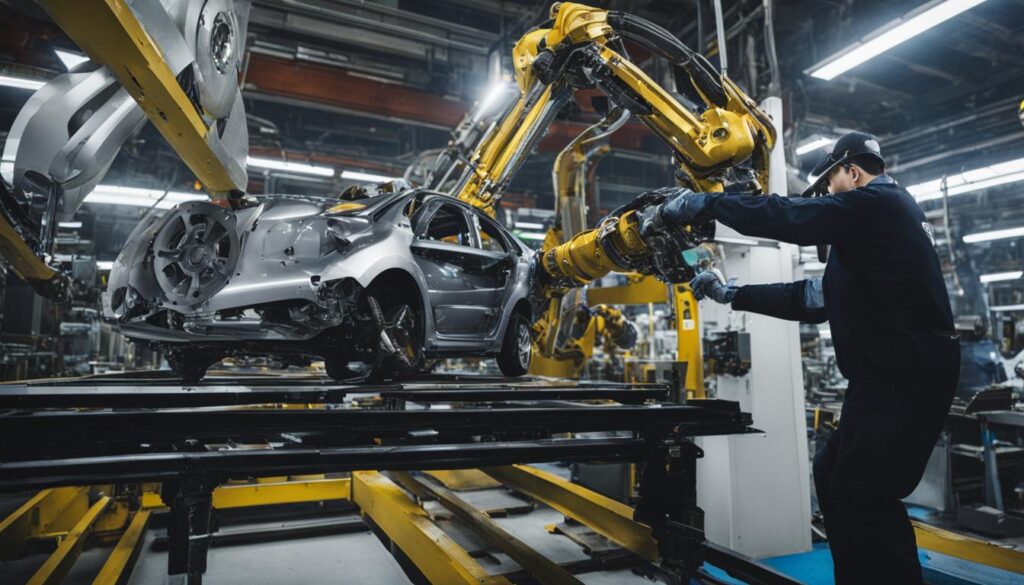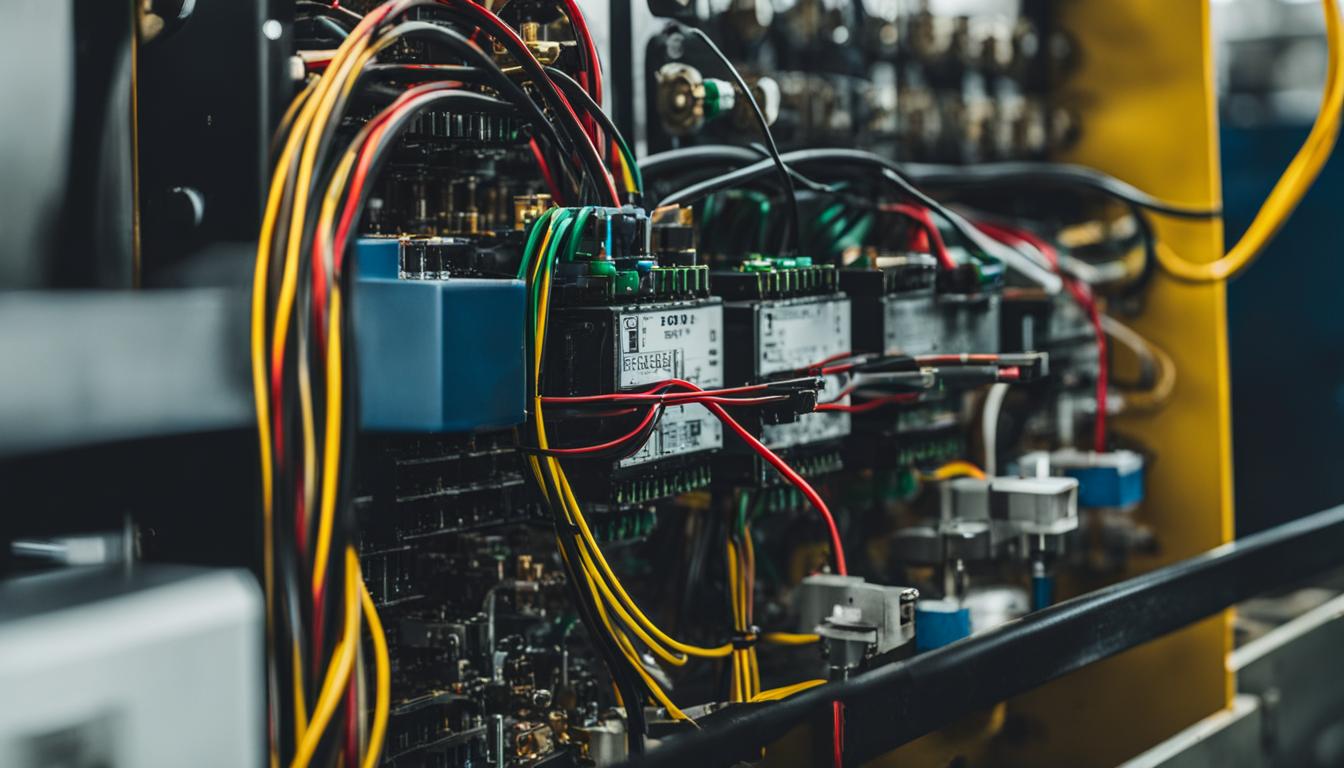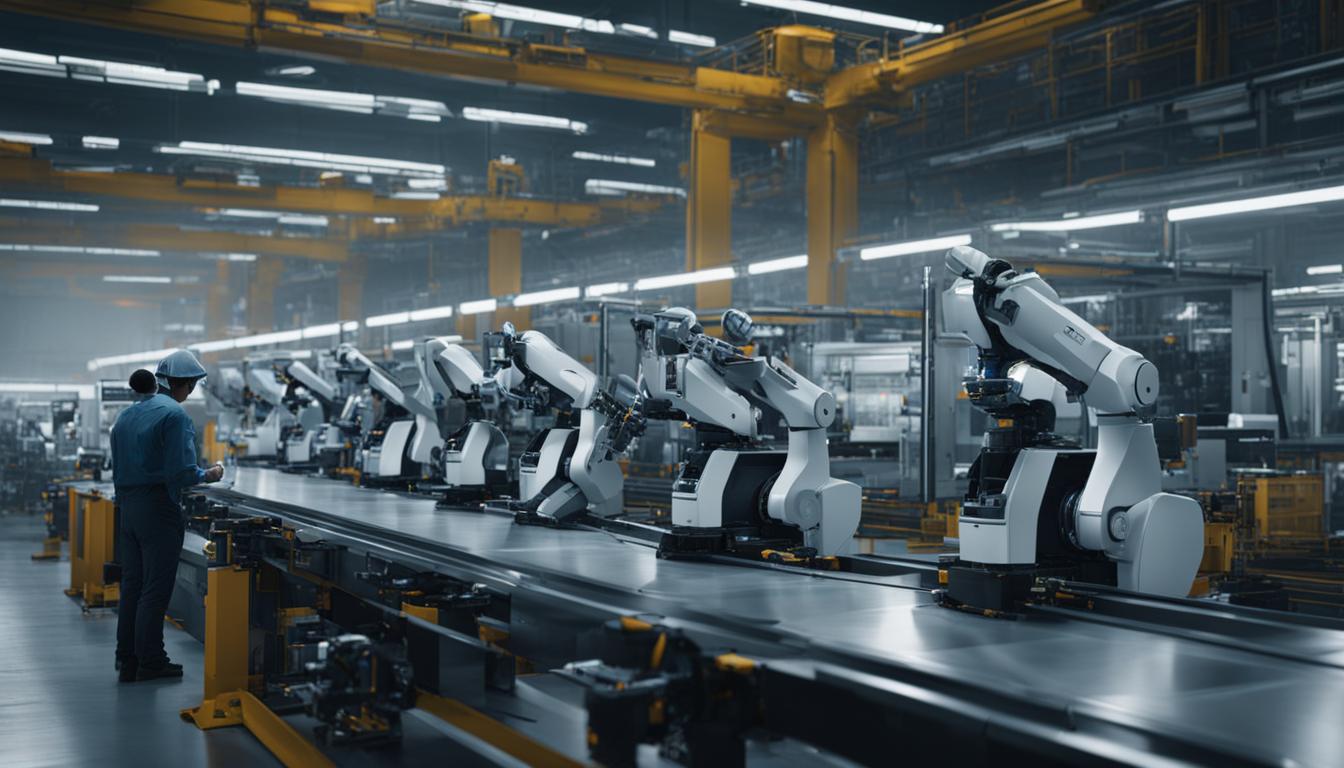Welcome to our beginner’s guide to programming robots! In this article, we will explore the fundamentals of robot programming and equip you with the essential knowledge to start your journey into the exciting world of robotics. Whether you’re a curious enthusiast or aspiring engineer, understanding the basics of programming robots is a crucial step towards unlocking the potential of these intelligent machines.
Robotics is an interdisciplinary field that involves designing, constructing, and operating robots. Robot programming plays a vital role in enabling robots to interact with their environment and accomplish specific tasks. It requires a combination of mathematical knowledge and proficiency in programming languages.
Popular programming languages in robotics include C/C++, Python, Java, C#/.NET, and MATLAB. These languages provide the tools and frameworks necessary to develop control schemes for robots. Additionally, the Robot Operating System (ROS) is widely used in robot software development, offering a comprehensive set of tools and libraries.
As the field of robotics continues to advance, the demand for skilled robot programmers is expected to grow significantly. By grasping the fundamentals of robotic programming, you can position yourself for exciting opportunities and make a meaningful impact in this rapidly evolving industry.
Key Takeaways:
- Robot programming involves developing a control scheme for robots to interact with their environment and accomplish tasks.
- Popular programming languages in robotics include C/C++, Python, Java, C#/.NET, and MATLAB.
- The Robot Operating System (ROS) is a widely used software framework for robot software development.
- Robot programming offers exciting career opportunities in a growing industry.
- By mastering the basics of programming robots, you can contribute to the advancement of intelligent machines.
The Fundamentals of Robotics Programming
Robotics programming is a fascinating field that involves designing and building computer programs to control robots. This process encompasses various aspects, including operator interface, mobility or locomotion, manipulators and effectors, sensing and perception, and programming.
The operator interface focuses on the interaction between a robot and its human controller. It involves designing intuitive user interfaces that enable seamless communication and control. This aspect is crucial for ensuring efficient and effective robot operation.
Mobility or locomotion is another essential element in robotics programming. It encompasses the methods by which a robot moves within its environment. Whether it’s a wheeled robot, a flying drone, or a legged machine, programming the movement and navigation capabilities is essential for the robot to carry out its tasks.
Manipulators and effectors refer to the specific components that allow robots to perform tasks. These can include robotic arms, grippers, or other specialized tools. Programming these components enables the robot to interact with objects, manipulate them, and carry out complex actions.
Sensing and perception play a crucial role in robotics programming. Robots need to gather information from their surroundings to make informed decisions and perform tasks accurately. Sensors such as cameras, depth sensors, and proximity sensors provide data that helps the robot to perceive its environment and adapt its actions accordingly.
Programming is at the heart of robotics programming. It involves developing the commands that control a robot’s actions. By coding algorithms and logic, programmers define how the robot behaves, responds to stimuli, and accomplishes its objectives.
| Aspect | Description |
|---|---|
| Operator Interface | Designing intuitive user interfaces for seamless human-robot interaction and control. |
| Mobility or Locomotion | Coding the movement and navigation capabilities of robots. |
| Manipulators and Effectors | Developing control algorithms for robotic arms, grippers, and specialized tools. |
| Sensing and Perception | Utilizing data from sensors to enable robots to perceive their environment. |
| Programming | Developing commands, algorithms, and logic to control robot actions. |
When it comes to selecting the programming language for robotics programming, several options are available. Each robot programming language offers its unique features and advantages. Some popular choices include C/C++, Python, and Java. The choice of programming language depends on factors such as the specific requirements of the project, the type of robot being programmed, and the programmer’s familiarity and preferences.
Understanding the fundamentals of robotics programming sets the foundation for anyone looking to delve into this exciting field. Whether you are a beginner or an experienced programmer, exploring the concepts and building practical skills in robot programming is an excellent way to unleash your creativity and contribute to the advancement of robotics.
Robot Programming Tools and Software
Robot programming is made efficient and effective with the use of specialized software tools. One such tool that stands out among programmers is the Robot Operating System (ROS). As a collection of software frameworks designed for robot software development, ROS provides a wide range of services and capabilities.
With ROS, programmers can benefit from features like hardware abstraction, low-level device control, and seamless message-passing between different processes. These functionalities enable smooth communication and integration of software components, making it easier to develop and control robots.

Another software tool commonly used in robot programming is MATLAB. While MATLAB is primarily known for its data analysis capabilities, it also integrates smoothly with ROS. This integration allows for seamless data processing and analysis within the ROS ecosystem.
Additionally, Arduino, a microcontroller platform that uses a programming language based on C, is often used in robot programming. Arduino simplifies the process of connecting sensors, motors, and other components, making it an excellent choice for prototyping and small-scale robotics projects.
These various tools and software, including ROS, MATLAB, and Arduino, offer different capabilities and options for programming robots. By leveraging these tools, programmers can tailor their programming approach to suit the specific requirements of each project, ensuring efficient and successful robot programming.
Programming Robots for Specific Tasks
When it comes to programming robots, the focus is often on achieving specific tasks or goals. This requires a well-defined robot control software architecture that enables seamless interaction between the robot and its environment, ultimately leading to successful task completion. The architecture typically consists of several key components:
- Supervisor: This component is responsible for overseeing the robot’s interaction with its surroundings. It ensures that the robot follows the desired control logic and responds appropriately to environmental changes.
- State Machine: A state machine represents the different states in which the robot can be during its operation. Each state defines a specific behavior or action that the robot can perform.
- Controllers: Controllers play a crucial role in implementing different behaviors based on the robot’s current state. They are responsible for executing the control algorithms and logic necessary to guide the robot’s actions.
Programming robots for specific tasks involves developing control algorithms that enable the robot to navigate its environment, avoid obstacles, manipulate objects, and perform various other actions. These algorithms are designed to ensure the efficient and accurate execution of the desired tasks, maximizing the robot’s effectiveness and productivity.
By programming robots with a well-designed control software architecture and implementing appropriate control logic, we can empower robots to perform complex tasks with precision and reliability. This capability opens up a wide range of applications in sectors such as manufacturing, logistics, healthcare, and more.
Example: Navigation Algorithm
One example of programming a robot for a specific task is developing a navigation algorithm. This algorithm allows the robot to autonomously move from one location to another, avoiding obstacles along the way. By utilizing sensor data and implementing obstacle detection and avoidance techniques, the robot can navigate its environment safely and efficiently.
Here is a simplified representation of a navigation algorithm:
| Step | Description |
|---|---|
| 1 | Receive the desired destination coordinates. |
| 2 | Perform localization to determine the robot’s current position. |
| 3 | Plan a path from the current position to the destination. |
| 4 | Execute the path by continuously monitoring sensor data and adjusting the robot’s trajectory to avoid obstacles. |
| 5 | Arrive at the destination and complete the task. |
By following this navigation algorithm, the robot can successfully navigate its environment and reach the desired destination while avoiding any obstacles or obstructions in its path.
Programming robots for specific tasks requires a combination of technical knowledge, problem-solving skills, and attention to detail. It is an iterative process that involves testing, refining, and optimizing the control algorithms and logic until the desired performance is achieved.

Through careful programming and the use of advanced control software architecture, we can unlock the full potential of robots, enabling them to perform specific tasks with efficiency, accuracy, and adaptability. The ability to program robots for specific tasks is a vital skill in today’s rapidly evolving technological landscape, with applications ranging from industrial automation to healthcare robotics.
Robot Programming Languages and Techniques
When it comes to robot programming, there is a wide range of programming languages and techniques available. These tools and approaches play a crucial role in developing efficient and effective robotic systems.
Popular robot programming languages include:
| Programming Language | Key Features and Capabilities |
|---|---|
| C/C++ | C/C++ is widely used in high-performance robotics applications. It offers low-level control and real-time processing capabilities, making it suitable for tasks that require fast execution. |
| Python | Python is favored for its simplicity, readability, and versatility. It offers a vast ecosystem of libraries and frameworks that simplify robot programming tasks. Python is commonly used for prototyping, scripting, and developing human-robot interaction systems. |
| Java | Java is a robust and object-oriented programming language. It provides extensive support for building distributed systems and integration with various hardware and software components. |
| MATLAB | MATLAB is widely used in robotics research for data analysis and simulation. It offers built-in tools for algorithm development, control system design, and sensor data processing. |
Robot programming techniques encompass a broad range of approaches that enable robots to perform specific tasks. One common technique is sensor-based programming, where robots use data collected from sensors to make decisions and execute actions. Sensor-based programming allows robots to adapt to their environment and respond dynamically to changing conditions.
The choice of programming language depends on various factors, such as the type of robot (mobile, industrial, humanoid, etc.) and the specific requirements of the programming task. Different languages offer different features and capabilities that are well-suited for specific applications.
Robot Control Signals
Robot control signals are essential for directing a robot’s actions and movements. These signals provide instructions for robot mobility, such as controlling motors, actuators, and joints. Control signals ensure precise and accurate control over a robot’s physical movements, enabling it to perform tasks with precision.
Code Example: Sensor-Based Robot Programming
Python example for sensor-based robot programming:
import rospy from sensor_msgs.msg import LaserScan def laser_callback(data): # Process laser scan data pass rospy.init_node('sensor_based_robot') rospy.Subscriber('/scan', LaserScan, laser_callback) # Begin main program loop rospy.spin()
In the given code example, we use Python and the Robot Operating System (ROS) to demonstrate a basic sensor-based robot programming approach. The code subscribes to a laser scan topic (“/scan”) and processes the received laser scan data. This data can be used for obstacle detection, mapping, or navigation purposes. Sensor-based programming provides robots with the ability to perceive their surroundings and make informed decisions based on real-time sensory input.
By leveraging the right programming languages and techniques, robot programmers can create sophisticated and intelligent robots capable of performing complex tasks. A combination of the right programming language, control signals, and sensor-based programming techniques empowers robots to interact with their environment effectively.
Conclusion
As the field of robotics continues to advance, programming robots effectively becomes increasingly important. From designing control architectures to implementing specific behaviors and tasks, robot programming plays a crucial role in the development and operation of intelligent machines.
By understanding the fundamentals of robot programming and becoming familiar with various programming languages and techniques, beginners can start their journey into the exciting world of robotics programming. With the increasing demand for robots across industries, mastering the basics of programming robots opens up opportunities for innovative and impactful contributions in the field.
From developing control algorithms to creating robot control logic, programming robots requires a deep understanding of how machines interact with their environment. By acquiring these skills, aspiring robot programmers can contribute to the advancement of technology and make a difference in various fields, from manufacturing to healthcare, transportation, and beyond.
As the technology continues to evolve, it is essential to stay updated with the latest advancements and programming techniques. This dynamic field offers endless possibilities, where creativity meets technology, driving the development of more intelligent and efficient robots. So, if you’re interested in the fascinating field of robotics, don’t hesitate to dive into the world of robot programming and embark on an exciting journey of exploration and innovation.
FAQ
What is robotics programming?
Robotics programming involves designing and building executable computer programs to control robots. It encompasses various fields, including operator interface, mobility or locomotion, manipulators and effectors, sensing and perception, and programming.
What are the popular programming languages in robotics?
Popular programming languages in robotics include C/C++, Python, Java, C#/.NET, and MATLAB. The use of Robot Operating System (ROS) is also common in robot software development.
What are some software tools used in robot programming?
Robot programming is often done using specialized software tools. Some popular tools include the Robot Operating System (ROS), MATLAB, and Arduino.
What is the Robot Operating System (ROS)?
The Robot Operating System (ROS) is a collection of software frameworks for robot software development. It provides services for hardware abstraction, low-level device control, message-passing between processes, and more.
What is involved in programming robots for specific tasks?
Programming robots for specific tasks involves developing control algorithms and logic to guide the robot’s behavior. This can include tasks such as navigation, obstacle avoidance, object manipulation, and more.
What programming languages and techniques are used in robot programming?
Popular programming languages in robot programming include C/C++, Python, and Java. Different techniques, such as sensor-based programming, can also be used depending on the specific requirements of the robot and task.




